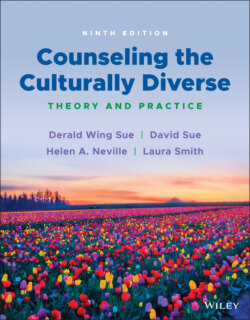Читать книгу Counseling the Culturally Diverse - Laura Smith L. - Страница 71
CHARACTERISTICS OF CONVENTIONAL COUNSELING
ОглавлениеAll theories of counseling and psychotherapy are influenced by assumptions that theorists make regarding the goals for therapy, the methodology used to invoke change, and the definition of mental health and mental illness (Corey, 2013). Given the Western European origins of conventional psychotherapeutic practice, it is not surprising that counseling and psychotherapy have historically and traditionally been conceptualized via Western individualistic concepts and terms (Ivey, Ivey, Myers, & Sweeney, 2005). Whether particular theories are psychodynamic, existential‐humanistic, or cognitive behavioral in orientation, multicultural specialists (Ivey, Ivey, & Zalaquett, 2014; Ponterotto, Utsey, & Pedersen, 2006) have explained that they usually share certain common components of White European American culture at the level of their underlying values and beliefs. Because this cultural worldview predominates in U.S. society, its assumptions have come to be taken for granted. This means that the mark that it makes on practices like psychotherapy can almost be invisible to mental health professionals, yet for individuals from diverse cultural backgrounds, it can be readily apparent, as illustrated in the passage that opened the chapter.
In addition to their origins in White European culture, standard psychotherapeutic practices have developed largely among middle‐class and affluent segments of the population (Smith, 2010). For this reason, the values, assumptions, and goals associated with psychotherapy correspond primarily to the lives and experiences of people with social class privilege rather than those of people living in poverty. Just as culturally diverse clients may not share the values and lifestyles assumed within the goals and the processes of therapy, neither may clients from poor or working‐class backgrounds (APA Task Force on Socioeconomic Status, 2007; Reed & Smith, 2014).
Katz (1985) has isolated some of the components of White European American culture that can be reflected in the goals and processes of clinical work. These components are summarized in Table 3.1. The sections that follow will refer to some of these components as we explore the ways in which culturally diverse clients may be excluded or inappropriately served by therapists who cannot see beyond dominant‐culture assumptions. This discussion of taken‐for‐granted mainstream values is just as important to the pursuit of multicultural competence as is a discussion of the traditions of diverse cultural groups. Learning about traditions, holidays, and other characteristics of various cultures around our country and around the world is, in fact, usually the easier part of the work—much easier that becoming aware of the everyday, taken‐for‐granted assumptions that can obstruct our full understanding of ourselves and the client who sits just across from us. As we explore these issues, what you'll find ahead in the chapter is:
A discussion of the ways that White European American cultural attitudes, expectations, and values emerge within conventional approaches to counseling and psychotherapy Table 3.1 Components of White Culture: Values and BeliefsSource: Katz, J. (1985). The Counseling Psychologist. Beverly Hills, CA: Sage. Copyright 1985 by Sage Publications, Inc. Reprinted by permission.Rugged individualismProtestant work ethicIndividual is primary unitWorking hard brings successIndividual has primary responsibilityProgress and future orientation Independence and autonomy are highly valued and rewardedPlan for futureIndividual can control environmentDelay gratificationCompetition Value continual improvement and progressWinning is everythingEmphasis on scientific method Win/lose dichotomyObjective, rational, linear thinkingAction orientation Cause‐and‐effect relationshipsMust master and control natureQuantitative emphasisMust always do something about a situationStatus and power Pragmatic/utilitarian view of lifeMeasured by economic possessionsCommunication Credentials, titles, and positionsStandard EnglishBelieve in “own” systemWritten traditionBelieve own system is better than other systemsDirect eye contactOwning goods, space, property are valued goalsLimited physical contactFamily structure Control of emotionsNuclear family is the ideal social unitTime Male is breadwinner and the head of the householdAdherence to rigid notions of timeFemale is homemaker and subordinate to the husbandTime is viewed as a commodityPatriarchal structureHolidays Aesthetics Primarily based on Christian religionMusic and art based on European culturesPrimarily based on White history and male leadersWomen's beauty based on blonde, blue‐eyed, thin, youngHistory Men's attractiveness based on athletic ability, power, economic statusBased on European immigrants’ experience in the United StatesReligion Romanticize warBelief in ChristianityNo tolerance for deviation from single god concept
A discussion of the mismatch of these attitudes with the experiences and values of other cultural groups, and how this mismatch undermines the effectiveness of therapy
A section that shows how even family therapy, which might seem to be more consistent with the values of many cultural groups, is based on theory and technique that clashes with many cultural group traditions
A section that underscores the importance of anticipating and accommodating non‐native English speakers
A presentation that links the foregoing discussion to therapeutic work with clients who live in poverty
A reminder that the information that we are learning is not to be applied to particular clients in “cookie‐cutter” fashion. Learning about the traditional values of various cultural groups is important to the development of our multicultural competence, but clients are individuals, and they may show some or none of the values that are traditionally associated with their cultures.
